Bill Gross, manager of the world's biggest bond fund at Pacific Investment Management Co., said the larger-than-forecast gain in employment suggests the Federal Reserve's policy of quantitative easing is working.
Bill Gross, manager of the world’s biggest bond fund at Pacific Investment Management Co., said the larger-than-forecast gain in employment suggests the Federal Reserve’s policy of quantitative easing is working.
Whether the gains in employment generated through government stimulus is sustainable is still in question once the Fed stops buying Treasuries, Gross said in a radio interview on “Bloomberg Surveillance” with Tom Keene.
Payrolls increased by 216,000 workers last month after a revised 194,000 gain the prior month, the Labor Department said today in Washington. Economists projected a March gain of 190,000, according to the median estimate in a Bloomberg News survey. The jobless rate dropped from 8.9 percent in February, the fourth straight decrease.
Gross wrote in a commentary this week that Treasuries “have little value” because of the growing U.S. debt burden. Gross eliminated government-related debt from his $237 billion Total Return Fund, the world’s largest mutual fund, last month for the first time since January 2009.
The U.S. has unrecorded debt of $75 trillion, or close to 500 percent of gross domestic product, counting what it owes on its bonds plus obligations for Social Security, Medicare and Medicaid, Gross wrote in his monthly investment outlook. The U.S. will experience inflation, currency devaluation and low-to- negative interest rates after accounting for consumer-price gains if it doesn’t reform its entitlement programs, he wrote.
The Total Return Fund has returned 6.9 percent in the past year, beating 82 percent of its peers, according to data compiled by Bloomberg. It gained 0.28 percent over the past month.
Pimco’s U.S. government-related debt category can include conventional and inflation-linked Treasuries, agency debt, interest-rate derivatives, Treasury futures and options and bank debt backed by the Federal Deposit Insurance Corp., according to the company’s website. The fund can have a so-called negative position by using derivatives, futures or by shorting.
Derivatives are financial obligations whose value is derived from an underlying asset. Futures are agreements to buy or sell assets at a later specific price and date. Shorting is borrowing and selling an asset in anticipation of making a profit by buying it back after its price has fallen.
Pimco, a unit of the Munich-based insurer Allianz SE, managed $1.24 trillion of assets as of December.
--Bloomberg







